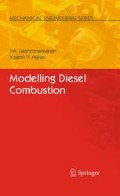Abstract
To contrast the phenomenon of HC formation in a Diesel and a spark ignition engine, a chapter is included on the latter. The absorption and desorption of fuel by cylinder lubricating oil films has been modelled using principles of mass transfer in this Chapter. Henry’s Law for a dilute solution of fuel in oil is used to relate gas to liquid phase fuel concentrations. Mass transfer conductances in gas and liquid phases are considered, the former via use of Reynolds’s Analogy to engine heat transfer data, the latter through assuming molecular diffusion through an effective penetration depth of the oil film. Oxidation of desorbed fuel is assumed complete if the mean of burned gas and lubricating oil film temperatures is greater than 100 K. Below this value, the desorbed fuel is considered to contribute to hydrocarbon emissions. Comparison with engine test data corroborates the absorption/desorption hypothesis. The model indicates the equal importance of gas and liquid phase conductance.
Access this chapter
Tax calculation will be finalised at checkout
Purchases are for personal use only
Preview
Unable to display preview. Download preview PDF.
References
Allen et al. DG (1975) Prediction of Piston Ring Cylinder Bore Oil Film Thickness in Two Particular Engines and Correlation with Experimental Evidence. IMechE Conference on Piston Ring Scuffing, London
Blint RJ, Bechtel JH (1982) Hydrocarbon Combustion near a Cooled Wall. SAE 820063.
Carrier G, Fendell F, Feldman P (1981) Cyclic Absorption / Desorption of Gas in a Liquid Wall Film. Combust. Sci. Technol., 25
Chappelow CC, Praushnitz JM (1974) Solubilities of Gases in High Boiling Hydrocarbon Solvents. AIChE Journal 20
Chigashi S, Hamamoto Y, Kizima A (1971) Effects of Turbulence on Flame Propagation in a Closed Vessel. Bull JSME, 14
Daniel WA (1957) Flame Quenching at the Walls of an Internal Combustion Engine. 6th International Combustion Engine
Daniel WA (1967) Engine Variable Effects on Exhaust Hydrocarbon Composition (A Single Cylinder Engine Study with Propane as the Fuel). SAE 670124, SAE Transactions 76
Dent JC, Lakshminarayanan PA (1980) Lean Burn Spark Ignition Engine combustion Modelling and Experiments. Symposium on Research in Internal Combustion Engines in UK Universities and Polytechnics, Kings College, London
Dent JC, Lakshminarayanan PA (1983) A Model for Adsorption and Desorption of Fuel Vapour by Cylinder Lubricating Oil Films and its Contribution to Hydrocarbon Emissions, SAE 830652
Ferguson CR, Keck JC, Oforah O (1976) A Theoretical Investigation on the Effects of Mixture and Flow Non-uniformities on Spark Ignition Engine Combustion. US Dept of Transportation, Interim Report, June
Hamamoto YH, Wakisaka T, Chigashi (1976) Limits of Flame Propagation in Spark Ignition Engines Behaviour of Flames and Exhaust Emissions. 16th FISITA Congress, Tokyo
Hires SD, Tabaczynski R, Novak JM (1978) The Prediction of Ignition Delay and Combustion Intervals for a Homogeneous Charge Spark Ignition Engine. SAE 78032, SAE Transactions 87
Kaiser EW, Adamczyk AA, Lavoie GA (1980) The Effect of Oil Layers on the Hydrocarbon Emissions Generated During Closed Vessel Combustion. 18th International Symposium on Combustion
Kaiser EW, Lorusso JA, Lavoie GA, Adamczyk AA (1982) The Effect of Oil Layers on the Hydrocarbon Emissions from Spark Ignited Engines. Combust. Sci. Technol., 28
Kreith F (1960) Principles of Heat Transfer. International Textbook Co., Scranton
Lakshminarayanan PA and Dent JC (1982) Generalised Procedure for Flame and Combustion Chamber Surface Determination in Spark Ignition Engines. SAE Paper 821223
Lakshminarayanan PA, Janakiraman PA, Gajendra Babu MK and Murthy BS (1979a) An Ultrasonic flow meter for measurement of Gas Velocity and Temperature in intake and exhaust of an Internal Combustion Engine. SAE Transactions, 790689
Lakshminarayanan PA, Janakiraman PA, Gajendra Babu MK and Murthy BS (1979b) New Instrumentation Technique for the study of unsteady Gas Exchange Process in engine Manifolds, Spring Meeting, Central States Section, The Combustion Institute, Apr 9–10, Columbus, Indiana
Lakshminarayanan PA, Janakiraman PA, Gajendra Babu MK, Murthy BS (1979c) Measurement of pulsating temperature and velocity in an internal combustion engine using an ultrasonic flow meter. Journal of Physics, E: Scientific Instruments 12, 1053–1058
Lakshminarayanan PA, Janakiraman PA, Gajendra Babu MK, Murthy BS (1979d) Prediction of Gas Exchange Processes in a Single Cylinder Internal Combustion Engine. SAE 790359
Lakshminarayanan PA, Nayak N, Dingre SV, Dani AD (2002) Predicting Hydrocarbon Emissions From Direct Injection Diesel Engine ASME paper
Lavoie GA (1982) Personal Communication
Lavoie GA, Lorusso JA, Adamczyk AA (1980) Hydrocarbon Emissions Modelling for Spark Ignition Engines. Symposium on Combustion Modelling in Reciprocating Engines, General Motors Research Laboratories, Nov 1978. Plenum Press, London
Lavoie GA, Blumberg PN (1980) A Fundamental Model for Predicting Fuel Consumption NO and HC Emissions of the conventional Spark Ignition Engine. Combust. Sci. Technol., 21
Locusso JA, Kaiser EW, Lavoie GA (1981) Quench Layer Contribution to Exhaust Hydrocarbons from a Spark Ignited Engine. Combust. Sci. Technol., 25
Schilling A (1968) Motor Oils and Engine Lubrication. Scientific Publications (GB) Ltd
Schlichting H (1955) Boundary Layer Theory. Pergamon Press, London
Sherman RH and Blumberg PN (1977) The Influence of Induction and Exhaust Processes on Emission and Fuel Consumption in the Spark Ignited Engine. SAE 770880, SAE Transactions 86
Spalding DB (1963) Convective Mass Transfer. Edward Arnold, London
Wentworth JT (1968) Piston and Ring Variables Affect Exhaust Hydrocarbon Emissions. SAE 680109, SAE Transactions 77
Woschni G (1967) A Universally Applicable Equation for the Instantaneous Heat Transfer Coefficient in the Internal Combustion Engine. SAE 670931, SAE Transactions 76
Author information
Authors and Affiliations
Corresponding author
Rights and permissions
Copyright information
© 2010 Springer Science+Business Media B.V.
About this chapter
Cite this chapter
Lakshminarayanan, P.A., Aghav, Y.V. (2010). Hydrocarbon Emissions from Spark Ignition Engines. In: Modelling Diesel Combustion. Mechanical Engineering Series. Springer, Dordrecht. https://doi.org/10.1007/978-90-481-3885-2_11
Download citation
DOI: https://doi.org/10.1007/978-90-481-3885-2_11
Published:
Publisher Name: Springer, Dordrecht
Print ISBN: 978-90-481-3884-5
Online ISBN: 978-90-481-3885-2
eBook Packages: EngineeringEngineering (R0)

